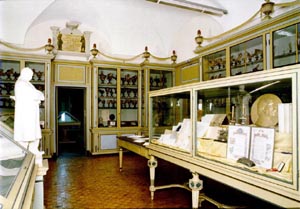This room contains most of the material connected with Camillo Golgi: microscope slides, docume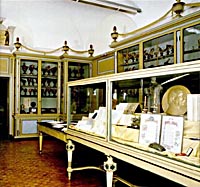 nts, apparatus, decorations conferred, and the Nobel Prize with the signatures of the Stockholm Carolingian Institute judges, dated 25 October 1906.
nts, apparatus, decorations conferred, and the Nobel Prize with the signatures of the Stockholm Carolingian Institute judges, dated 25 October 1906.
Some of the specimens organised and studied by Camillo Golgi are in an original setting, which he invented to suit his method of studying nerve tissue, called "black reaction" or "silver-chrome".
In the show-case containing a bronze bust of Golgi, there are also two of the first microscopes which he himself used and the first microtome, with 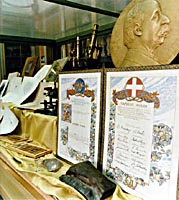 which he cut up thin slices of nerve tissue, for his method of microscopically studying various parts of the nervous system. Apart from the volumes of his Complete Works, his hand-written documents and original drawings are of special interest. They deal with the structure of cells, the nervous system, kidneys, studies on malaria, as well as some manuscript notes which he used in his general pathology lectures.
which he cut up thin slices of nerve tissue, for his method of microscopically studying various parts of the nervous system. Apart from the volumes of his Complete Works, his hand-written documents and original drawings are of special interest. They deal with the structure of cells, the nervous system, kidneys, studies on malaria, as well as some manuscript notes which he used in his general pathology lectures.
In the same room, there are other documents and manuscripts: Adelchi Negri's on the discovery of rabies, and Carlo Forlanini's, together with the earliest glass instruments for pneumo-thorax therapy, which led to the construction of simpler and more practical ap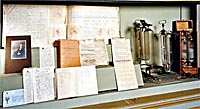 paratus for the therapy which was used thereafter.
paratus for the therapy which was used thereafter.
Other Forlanini relics are also on show: a bronze shield with his effigy, a portrait of him as a young man, some hand-written manuscripts, and the photograph of a young woman , one of the first patients to try out the pneumo-thorax therapy. On the photograph can be seen semiotic lines drawn on the young woman's thorax, and, beside them, Forlanini's notes on the patient's physical condition.
Edoardo Porro is shown in a bronze sculpture, and there is the surgical instrument used by him in the very first hysterectomy, performed in Pavia in 1876, together with the part he removed, preserved in formaldehyde.
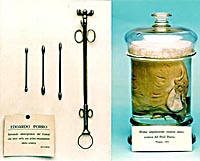 G.B Amici's composite achromatic microscope, one of the first of its type, made about 1826, is on show as are his hand-written instructions on the use of the apparatus. Because of its extreme reduction in the chromatic aberration of the lenses, this tiny pocket microscope he invented turned out to be a fundamental step forward in the history of microscopes.
G.B Amici's composite achromatic microscope, one of the first of its type, made about 1826, is on show as are his hand-written instructions on the use of the apparatus. Because of its extreme reduction in the chromatic aberration of the lenses, this tiny pocket microscope he invented turned out to be a fundamental step forward in the history of microscopes.
Other interesting exhibits are the reproductions of Amici's wax models, which he made to demonstrate his discovery of plant fertilisation, models of the structure and reproduction system of the truffle, and of the cryptogam parassite on the rose.
Apart from Eusebio Oehl's collection of microscope slides, the cannulas are on show which he got made and used via experimental fistulas to examine the digestive tract. Also to be seen are the cannulas to surround salivary ducts and thus to collect the various types of saliva. Oehl's manuscripts on view include reports of some experiments, lecture notes and a few pages of his Treatise on Physiology, of which the Museum has the entire work.
There is a small showcase containing commemorative medals and coins struck in honour of famous alumni of Pavia University.
In this same room are to be found X-ray plates dating from 1986, and a photograph reproduced by using Roentgen's X-rays.
